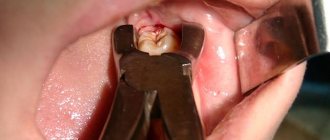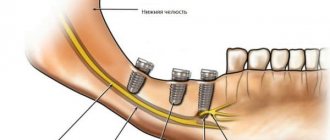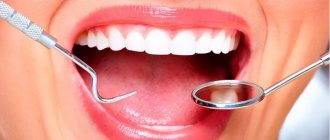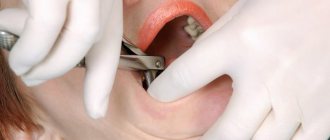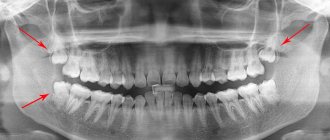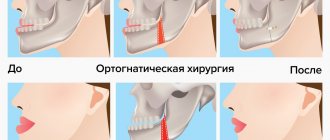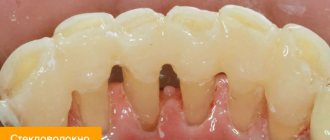From this article you will learn:
- how wisdom teeth are removed - photos and videos,
- how painful it is, what complications there are,
- price for wisdom tooth removal in Moscow.
The article was written by a dental surgeon with more than 19 years of experience.
Removing a wisdom tooth in dentistry - in half of the cases, is a complex surgical operation, which is associated with the difficulty of extracting the tooth from the dental alveoli (for example, due to severely curved roots or abnormal position in the jaw). Of all the human teeth, it is the eruption of wisdom teeth that causes patients the most discomfort, which usually happens when there is not enough space in the dentition for their eruption. And in this case, their removal also helps prevent crowding of the front teeth.
The times when dental surgeons hollowed out wisdom teeth using a surgical chisel and hammer are long gone. And even more so, none of the dentists use such a weak anesthetic as novocaine for pain relief. Currently, if a wisdom tooth is in such a position that it cannot be removed entirely from the jaw (without causing significant injury to the surrounding tissues), the doctor uses a special water-cooled drill. This allows you to separate the tooth into parts, quickly removing the roots individually.
Removal of the eighth tooth (wisdom tooth) –
The decision to remove already erupted wisdom teeth is made based on the possibility and necessity of using them for prosthetics in the future. It is very easy to remove a wisdom tooth, but effectively restoring the end defects of the dentition (if you do not have 6-7-8 teeth) can only be done with dental implantation. Therefore, sometimes even a severely damaged eighth tooth is worth restoring in order to later use it as a support for a bridge or to improve the fixation of removable dentures.
If we are talking about removing wisdom teeth that have not yet erupted (or partially erupted), then in adolescents it is optimal for the orthodontist to make the decision. The rudiments of the eighth teeth are formed in children aged 4-5 years, while the formation of the crown part ends at approximately 12 years, and the complete formation of roots - only at 24 years. If necessary, a teenager can have his unerupted eighth teeth removed, i.e. with not yet fully formed roots.
Is it painful to remove a lower wisdom tooth?
The figure eights below and the human lower jaw have a number of features.
- Well formed and often curved roots of third molars.
- The bone tissue of the lower jaw is denser (compared to the upper jaw).
- The soft tissues are elastic and adhere tightly to the crown of the tooth.
All this creates certain difficulties for the dentist and he has to make efforts to extract the tooth. But this does not mean that the molar will have to be roughly pulled out, causing painful suffering to the patient. On the contrary, the operation to remove the lower eight is considered complex, so it is carried out with the utmost care, care and delicacy.
Patient reviews of the procedure indicate that the degree of pain directly depends on the actions of the dentist. If he carefully examined the location of the problematic molar and administered anesthesia correctly, then there is no severe pain, the patient may feel mild discomfort and minor pain. And, on the contrary, if the doctor acts incorrectly, patients experience suffering.
There is no need to be afraid of having your lower wisdom tooth removed. It is better to spend a little time finding a good specialist who can perform the procedure correctly, painlessly and safely.
Simple extraction
During this procedure, the gum is not cut or the bone is drilled. In this case, it is unlikely that at least part of the root will remain inside the hole. Before removing a wisdom tooth, an anamnesis of the pathological processes that are present is analyzed, and it is also determined whether there is an allergy to medications. Is it painful to remove a lower wisdom tooth? It all depends on the complexity of the process.
Here the whole process is divided into several stages:
- anesthesia;
- removal of a tooth;
- suturing the wound and its edges.
Is it painful to remove an upper wisdom tooth?
Unlike the lower jaw, the structure of the upper jaw is less problematic.
- Bone tissue of medium density.
- Soft tissues are equipped with an extensive network of blood vessels, which simplifies the process of pain relief.
- Eights have relatively “even” roots.
Thanks to this, removing the figure eights from above is quick and painless. And this is confirmed by reviews from patients who have already had their wisdom teeth pulled out.
Note! It is not recommended to endure toothache for a long time by taking painkillers on your own. This can make the removal procedure more difficult and painful. Therefore, it is better not to postpone a visit to the dentist.
What painkillers are used
For painless removal of wisdom teeth, modern methods of local anesthesia are used.
- Conduction anesthesia - an anesthetic injection is given in close proximity to the molar nerve.
- Intraligamentary anesthesia - injections of anesthetic are placed into the circular ligament of the tooth.
- Infiltration anesthesia - an anesthetic is injected into soft tissues (the method is rarely used due to low efficiency, especially on the lower eights).
The most effective anesthetics today are drugs based on articaine - Septanest, Ultracaine, Ubistezin. Their effectiveness is 2 times higher than that of Lidocaine, and 6 times better than that of Novocaine. The analgesic effect after the administration of articaine drugs occurs almost immediately and lasts for 1 to 5 hours.
- Septanest - the drug contains adrenaline and preservatives (not recommended for use by patients prone to allergies).
- Ultracaine - with and without epinephrine (the drug does not contain preservatives).
- Ubistezin is a drug with varying concentrations of epinephrine.
Important! Before choosing an anesthetic, it is necessary to warn the dentist about any contraindications to its use - allergies, diseases of the cardiovascular system, diabetes, bronchial asthma, etc. This will help you choose the right drug and avoid complications.
Types of anesthesia
When a molar needs to be removed, anesthesia should be performed. There are three anesthesia options for this:
- local. Is it painful to have a wisdom tooth removed with this type of anesthesia? It is used most often. It acts in a specific area and relieves nerve endings of sensitivity;
- general anesthesia. Sometimes the patient does not have enough local anesthesia. Then anesthesia is used if the patient suffers from mental disorders, is terrified of surgery, and has a gag reflex. With such anesthesia, a person simply falls asleep;
- combined. Here, medications that promote relaxation and local anesthesia are simultaneously used. The patient remains conscious, but his emotional and physical levels decrease.
Is it painful to have a wisdom tooth removed? With high-quality anesthesia, you will not feel anything.
How long will an extracted tooth hurt?
Wisdom tooth extraction is a dental surgery. It implies inevitable injury to the soft and hard tissues of the oral cavity. Naturally, after the end of the anesthetic, they will hurt. Normally, pain after the removed figure eight is present for 2 to 5 days. It can be minor or severe, aching or acute. Its location may be the socket of an extracted molar or the entire jaw. It is possible that the pain will radiate to the temporal region, ear or throat.
As the hole heals, the pain will subside. If stitches were placed on it, then on the 7th – 10th day it is necessary to visit the dentist to remove them. This process is unpleasant and a little painful. Therefore, patients with a low pain threshold are usually given local anesthesia - the gums are treated with an anesthetic spray (or gel).
Final healing of the hole occurs only at the end of 2 - 3 weeks after the removal of the figure eight. Careless actions during this period can lead to pain. Therefore, caution should be exercised when eating and performing hygiene procedures.
Patient reviews
Review 1
Before describing the procedure, I want to talk about my pain threshold. I can NOT stand pain. At all! I LOVE IT!!! For example, before treating caries, I ask you to give me 2 painkiller injections. And then one day my wisdom tooth began to hurt. I endured it steadfastly! But patience has come to an end! I had to go to the clinic.
Sitting down in a chair, I, as usual, asked for 2 injections and mentally prepared myself for torture :) Instead of somehow supporting and encouraging me, the doctor said: - Nahhh... but the tooth is in an inaccessible place! You can’t even get close to him!!!
Then she asked me to open it wider, then even wider, then again and again... It seemed to me that the corners of my mouth were already torn, and the doctor kept asking me to make my “mouth wider”! At the same time, she said, “What can I do here...” and tried to pick up the tooth with pliers.. These attempts lasted about 5 minutes. There was no particular pain, it was just unpleasant that the doctor could not pick up the tooth and was scared from waiting for the outcome. In the end, I asked: - Maybe I’ll go already?!!! If she can’t pick up a tooth, then WHAT will happen next?! To my deep surprise, the doctor did not even try to persuade me to stay and complete the procedure. She simply said: “Go!”
Well, wow :) This has never happened to me before. Usually doctors persuade: - Well, be patient... If you came, then you need to be patient. And here on you - go... I ask: - And what to do now? The answer was: “Nothing!” Rinse! And don't eat anything for 2 hours. And don't drink anything hot all day. - Why??? - Because the wound should heal. - So you REMOVED my tooth??? - Yes!
Just like that! While I was preparing for “medieval torture” and many hours of torment, the specialist did her job! BRAVO!!! I was delighted! After a couple of hours, the freezing sensation began to subside and the pain returned. She was tolerable, rinsing helped. After a few days the pain went away, but the wound healed for probably a whole month! The pain was weak and dull... The gums ached a little and as if something was pulling. But everything ended well! Everything is overgrown evenly.
Review 2
One of the four teeth had grown into the gum and began to rot there. Therefore, when I came to my favorite dentist, there was only one diagnosis - the wisdom tooth needed to be removed. I honestly couldn’t even get scared when I was already given anesthesia and the fragile dentist started pulling my tooth.
From the sensations, I can’t say that it hurt, no, the anesthesia worked well, but there was a feeling, I felt the tooth being taken with forceps, how it was being pulled, and I was even surprised how my fragile doctor pulled out this chunky tooth. He fought hard to get out, but for professionals there are no problems.
After this, of course, my gums bled a little, I was prescribed mouth rinses so that everything would heal faster. My gums healed within a day. I did not feel any discomfort due to the missing wisdom tooth.
Therefore, I can say for sure that the devil is not as scary as he is painted. Yes, it was unpleasant, but not painful and it could be tolerated. And if I have to remove the rest of my wisdom teeth, I won’t be the least bit upset or scared. Since there is nothing scary in this procedure.
How to understand that it is time to remove a wisdom tooth
According to modern dentists, a wisdom tooth is a vestigial organ that does not carry a serious functional load. But still! If its appearance does not cause suffering and is not a potential threat to the general condition of the oral cavity, then you should not rush to remove the figure eight. After all, no one knows how the patient’s life will turn out and, perhaps, in the future the tooth will be needed as a support for installing a bridge.
Indications for removal of the third molar are the following pathologies and conditions.
- Incorrect placement of the figure eight or tooth roots.
- The development of pericoronitis is inflammation of the gums surrounding the problematic tooth.
- Lack of space in the dentition for an erupting molar.
- III degree of mobility of the figure eight.
- The crown of the erupted tooth is affected by caries and gradually collapses.
- The appearance of a wisdom tooth can harm the units in front of the dentition.
- It is planned to correct the bite and install braces.
The feasibility of treatment and removal of the figure eight is determined by the dentist. The patient can listen to his recommendations or insist on his own, refusing qualified help from a specialist. But it is forbidden to pull a tooth on your own - this is fraught with the development of serious complications.
How to prepare for removal
If the process of the emergence of the third molar causes concern or is accompanied by pain, then it is necessary to show the problem unit to the dentist as soon as possible. You should not postpone a visit to the clinic, abuse painkillers or use “miracle” folk remedies - this will not help solve the problem and may worsen it.
After treatment, there are 2 possible scenarios - the wisdom tooth will be treated or removed. To properly prepare for removal, just follow a few simple recommendations.
- 1 - 2 days before the procedure, stop taking alcohol and anticoagulants - drugs that impair blood clotting, for example, Aspirin, Heparin, Ibuprofen.
- On the eve of the operation, it is better not to practice warming procedures - go to the bathhouse, sauna, solarium, or steam your feet.
- Be sure to eat 1 – 2 hours before removal.
- Before visiting a doctor, thoroughly brush your teeth and mouth with a regular toothbrush and toothpaste.
Immediately before removing a wisdom tooth, it is recommended to lubricate your lips with Vaseline or hygienic lipstick - this will protect them from the formation of cracks. As a rule, in good clinics the dentists do this themselves, but just in case, it is better to take the product with you from home.
It is important to know! According to the observations of dentists, seeking help earlier guarantees a less painful procedure.
This is due to the fact that the place where the figure eight appears is not yet “exhausted” by pain, slightly inflamed, without swelling and other unpleasant symptoms. In this case, an injection of anesthesia will be sufficient to completely numb the procedure.
If you endured it for a long time, took pills, and then couldn’t stand the torment and asked for help, then you need to be prepared for the fact that, most likely, the operation will be more painful and the dentist will have to use a larger dose of anesthesia, which is not always possible.
Regardless of the time of treatment, it is necessary to understand that figure eight extraction is a rather complex process from a technical point of view, requiring the efforts of a doctor. Naturally, tooth extraction will be accompanied by unpleasant sensations. The degree of their manifestation depends on the patient’s pain threshold - therefore it is better to warn the specialist in advance about the characteristics of your body.
Removal steps
Before removing the third molar, it is necessary to conduct an X-ray examination of its condition. An x-ray will show what position the figure eight occupies and what roots it has. After this, one of the operation options will be selected - simple or complex removal.
Easy removal
Typically, a simple operation is performed to remove upper or lower teeth with well-formed crowns and non-crooked roots. The procedure involves several stages.
- Local anesthesia.
- Extraction of a wisdom tooth from the socket.
- Antiseptic treatment of the resulting wound.
- Applying a tampon soaked in an anti-inflammatory solution.
- Suture application (if indicated).
Simple removal takes approximately 5 – 10 minutes.
Difficult removal
Complex intervention is necessary in cases where the third molar has a destroyed crown, well-branched or curved roots, or has not fully erupted. Its implementation involves the following steps.
- Anesthesia.
- Exposure of the molar by gum resection.
- Creating a hole in the jaw bone, separating the crown and roots of the tooth with a drill (according to indications).
- Extraction of the figure eight and its parts.
- Antiseptic treatment of the hole.
- Stitching.
Complex removal can last 20 – 160 minutes.
Note! Both simple and complex removal are performed on an outpatient basis and do not require hospitalization of the patient. After the procedure is completed, in the absence of dangerous symptoms, he goes home and must follow the recommendations of the attending dentist.
Recovery period
How long does recovery take after removal of upper wisdom teeth and what limitations does it impose? In most cases, after 1-2 days the patient returns to normal life, but sometimes recovery takes longer. To prevent the rehabilitation period from being prolonged, it is very important to follow the doctor’s recommendations:
- take prescribed antibiotics, painkillers and anti-inflammatory drugs;
- do not visit the bathhouse, sauna, swimming pool, or take a bath;
- follow a diet, if possible, eat only soft foods;
- refrain from smoking.
If the doctor did not make mistakes during removal, and the patient carefully followed all the doctor’s recommendations, then the recovery period will pass quickly, and the problem of the upper “eights” can be forgotten forever.
Recommendations after removal
After a simple or complex figure eight extraction, you must adhere to the following recommendations.
- Do not eat or drink for 2 – 3 hours after removal.
- For the first 1–2 days, do not eat the side of your mouth with the extracted tooth.
- For the first 1–2 days, avoid sports, heavy physical labor and thermal procedures.
- For the first day, refrain from hygienic cleaning of the oral cavity.
- For the first 1–2 days, do not drink alcoholic beverages and give up cigarettes.
Important to remember! The tampon applied to the resulting wound must be held for 10 - 20 minutes. Afterwards, it can be deleted. Under no circumstances should you “feel” the hole with your tongue - this can lead to premature washing out of the clot.
Talk about a clot! The resulting clot is necessary for normal wound healing. It cannot be taken out and rinsed. It is for this reason that any rinsing of the mouth with “miracle” solutions is prohibited. After the time required by the body has passed, the clot will come out on its own.
You also can’t warm up your cheek or massage it. To relieve swelling, you can use cold compresses, which are applied for 1 to 2 minutes. And if severe pain occurs, it is recommended to take an analgesic - Ibuprofen, Analgin, Sedalgin, Pentalgin.
Important! Avoid drugs based on salicylic acid (for example, Aspirin) - they reduce blood clotting, which can cause bleeding from the socket.
Important to remember! If the pain does not go away after taking analgesics and intensifies, and the patient becomes ill, has a high fever, severe swelling, chills and other dangerous symptoms, then you should immediately seek help from a doctor.
What to do if the bleeding does not stop
Immediately after removing a molar, the surgeon places a tampon on the socket to stop capillary bleeding. The patient needs to clench his jaw and not remove the tampon for 20 minutes. During this time, the blood coagulates and a clot forms in the hole, protecting the fresh wound from the penetration of bacteria into it.
If the patient has high blood pressure or poor blood clotting, the tampon should be kept in place for 40-60 minutes.
When a person strictly adheres to medical recommendations, but the bleeding does not stop, he should contact a dentist for help.
How long will it take for gums to heal after wisdom tooth removal?
Complete healing occurs after 10 – 12 months. This is a rather lengthy and complex process, involving several mandatory steps.
- Complete healing of the resulting wound (socket) occurs 2 to 3 weeks after extraction.
- Formation of new bone tissue - up to 2 months from the moment of complete healing of the hole.
- Consolidation of bone tissue – up to 4 months from the moment the new tissue appears.
- Fusion of gums and new bone tissue takes up to 10–12 months from the date of extraction.
The speed of healing is influenced not only by wound care and external influences, but also by internal factors - the patient’s age, the state of his health and immune system. Therefore, during this period it is very important to monitor your well-being and follow all the recommendations of the dentist and attending physician.
Why complications arise
After extraction, a wound is left in the gum and bone in which a blood clot (fibrin) forms. It “seals” the wound, preventing infection, and becomes the basis for the formation of new tissue that fills the space formed after the removal of the 8. After uncomplicated removal, healing lasts about a week. On days 3-4, the blood clot is gradually replaced by granulation tissue, which gradually fills the entire socket. Already after a month, the granulation tissue is completely replaced by connective tissue, and after 3 months - by bone.
Removal of third molars can have negative consequences that appear almost immediately after the intervention. Among the most common complications:
- “dry socket” - when a blood clot does not form or dissolves too quickly;
- paresthesia - damage to the nerve endings around the removed unit;
- alveolitis - inflammation of the socket;
- bleeding;
- cyst - fibrous formation at the site of an extracted tooth;
- endogenous periostitis (flux).
In rare cases, stomatitis, osteomyelitis, jaw trauma, and perforation of the bottom of the maxillary sinus are observed. The occurrence of complications is usually associated with ignoring the dentist’s recommendations regarding oral hygiene during the healing period, decreased immunity, and violation of surgical technique.
